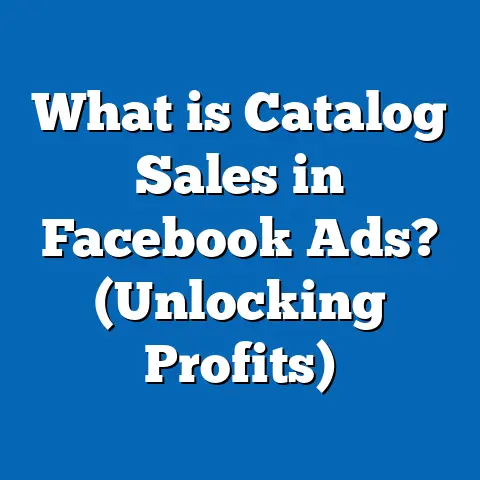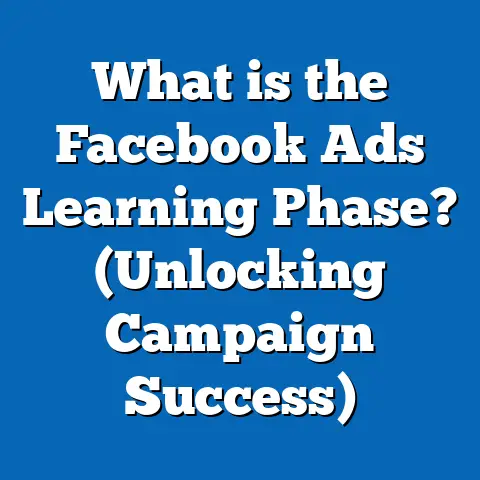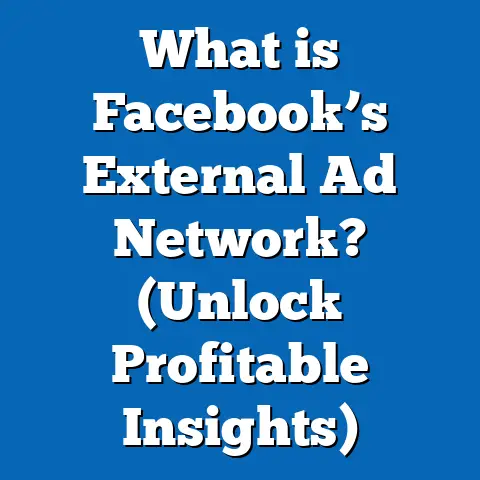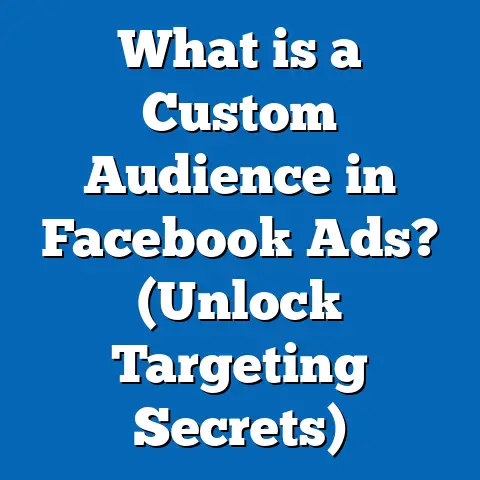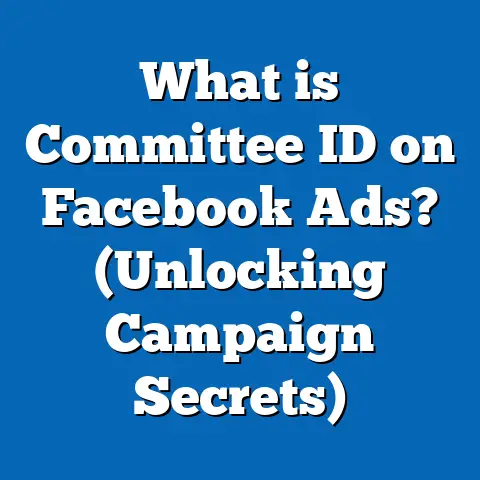What is a Facebook Ad Boycott? (Understanding the Backlash)
Introduction: The Craftsmanship of Advertising and the Power of Facebook
Craftsmanship is the art of carefully shaping raw materials into something purposeful and beautiful. It embodies skill, precision, and attention to detail. In advertising, marketers act as craftsmen, meticulously designing campaigns that resonate emotionally and logically with their audience. Every element—from imagery to copy to placement—is chosen with care to deliver a message that influences decisions.
Facebook has become one of the most dominant platforms for digital advertising craftsmanship. Its vast global user base of nearly 3 billion monthly active users offers marketers unparalleled access to diverse audiences. The platform’s sophisticated targeting tools allow brands to deliver highly personalized ads designed to maximize engagement and conversions.
But with great power comes great responsibility—and sometimes backlash. The very platform that enables marketers to craft targeted campaigns has faced significant criticism over content moderation failures, misinformation, and ethical concerns. These issues have led to a phenomenon known as the Facebook Ad Boycott—where advertisers collectively pause or withdraw spending on Facebook as a form of protest.
For marketing professionals and business owners, understanding the Facebook Ad Boycott is critical. It reveals the complex balance between leveraging Facebook’s advertising power and maintaining brand integrity amid growing social pressures. This article offers an in-depth exploration of Facebook Ad Boycotts, their causes, impacts, responses, and practical implications.
What is a Facebook Ad Boycott?
Definition and Overview
A Facebook Ad Boycott is when advertisers intentionally halt or reduce their ad spending on Facebook to protest certain platform policies or practices. This collective action serves as a demand for change or a statement against perceived harmful elements on the platform.
Unlike standard changes in ad budgets driven by market dynamics or seasonality, boycotts are deliberate and coordinated moves often publicized through campaigns or coalitions. They reflect broader concerns about the platform’s role in society and the ethical responsibilities of advertisers.
Motivations Behind Facebook Ad Boycotts
Advertisers may boycott Facebook for several reasons:
- Content Moderation Issues: Fear that ads are displayed alongside hate speech, violence, or extremist content.
- Misinformation Spread: Concerns over false news that can harm public discourse or health (e.g., COVID-19 misinformation).
- Brand Safety Risks: Worry about negative association harming brand reputation.
- Social Justice and Ethics: Desire to align advertising spend with corporate values and social responsibility.
- Demand for Transparency: Calls for clearer policies around how Facebook handles content and ad placements.
Scope and Scale of Boycotts
Facebook ad boycotts often involve hundreds or thousands of companies across industries—from consumer goods to technology to nonprofits. While some are short-term protest actions, others have longer-term effects on advertising strategies.
Historical Context: Evolution of Facebook Ad Boycotts
Early Concerns: Brand Safety Before 2020
Before the high-profile 2020 boycott, advertisers were already concerned about brand safety on Facebook. Reports surfaced about ads appearing next to conspiracy theories, graphic violence, or extremist group content.
In 2017–2019, some advertisers began using brand safety tools like placement exclusions or partnered with third-party verification services (e.g., Integral Ad Science) to monitor risks.
The 2020 #StopHateForProfit Campaign: A Watershed Moment
The 2020 boycott was unprecedented in scale and impact. Initiated by civil rights groups such as the NAACP and the Anti-Defamation League (ADL), the campaign urged brands to pause Facebook ad spending during July 2020 to protest the platform’s handling of hate speech and political misinformation.
- Participation: Over 1,200 companies joined, including Coca-Cola, Verizon, Unilever, Patagonia, and many others.
- Duration: Most paused ads for at least a month; some extended beyond.
- Media Coverage: Widespread coverage amplified public awareness and scrutiny.
Impact on Facebook
- Revenue loss estimated at $100 million in Q3 2020.
- Led to public commitments by Facebook CEO Mark Zuckerberg to improve content moderation.
- Accelerated investment in AI tools and transparency reporting.
Follow-Up Boycotts and Movements
Since then:
- Some advertisers have resumed spending cautiously.
- New boycotts emerged related to COVID-19 misinformation.
- Ongoing discussions about platform responsibility persist.
Data and Insights: Measuring the Effects of Facebook Ad Boycotts
Financial Impact on Facebook
| Quarter | Estimated Revenue Loss | Notes |
|---|---|---|
| Q3 2020 | $100 million | Direct result of #StopHateForProfit |
| Q4 2020 | $50 million | Partial recovery as some brands returned |
| 2021 | Minimal | Diversified revenue from other platforms |
Facebook’s overall ad revenue in 2020 was around $84 billion; thus, the boycott’s impact was significant but not catastrophic. The company’s scale allowed it to absorb losses while implementing changes.
Advertiser Sentiment Data
A survey by eMarketer (2021) found:
- 62% of U.S. marketers cited brand safety as a top concern when advertising on social media.
- 45% indicated they would reduce spend if they perceived platform policies as insufficient.
- Around 30% participated in or supported boycott efforts in some form.
Brand Safety Improvements Post-Boycott
Facebook reported a 40% increase in hate speech detection efficacy in the year following the boycott due to improved AI systems.
Understanding the Backlash: Why Does It Matter for Marketers?
Brand Safety: Protecting Your Reputation
Brand safety means ensuring your ads do not appear next to inappropriate or harmful content. Negative associations can erode customer trust and cause lasting damage.
For example:
- Ads displayed next to violent or hateful content can cause consumer outrage.
- Negative PR from such placements can lead to stock price drops or lost partnerships.
Ethical Advertising: Aligning with Consumer Values
Consumers today expect brands to demonstrate social responsibility. According to a 2023 Edelman Trust Barometer study:
- 64% of consumers consider a company’s social values when deciding what to buy.
- Brands perceived as unethical lose up to 30% of customer loyalty.
Boycotting Facebook sends a message that brands prioritize ethics over profits when platform policies fall short.
Platform Influence: Leveraging Power for Change
Advertisers hold significant influence over platforms through their ad spend. Boycotts are a way to exert pressure and demand improvements in:
- Content moderation
- Transparency of algorithms
- Accountability for misinformation spread
How Facebook Responds: Policy Changes and Technical Innovations
Strengthening Content Moderation
Facebook has committed billions annually to improve content review processes:
- AI Algorithms: Enhanced machine learning models identify hate speech, violent content, and misinformation faster.
- Human Review: Increased hiring of content moderators worldwide.
- User Reporting: Easier tools for users to flag content.
Transparency Reports
Facebook now publishes detailed transparency reports quarterly covering:
- Number of posts removed for hate speech or misinformation
- Details on ad placements and enforcement actions
- Progress updates on policy changes
Brand Safety Tools for Advertisers
Facebook introduced:
- Placement Controls: Allow advertisers to exclude certain placements (e.g., instant articles).
- Inventory Filters: Options like “Limited,” “Standard,” or “Full” inventory based on risk tolerance.
- Third-party Verification Integration: Partnerships with companies like DoubleVerify for independent assessments.
Practical Implications for Marketers: Navigating the Environment Post-Boycott
Assessing Your Brand’s Risk Profile
Ask:
- How sensitive is your industry (e.g., children’s products vs. gaming)?
- How vocal is your audience about social issues?
- What level of risk tolerance do you have regarding ad placements?
Best Practices for Brand Safety on Facebook
- Use placement exclusions proactively.
- Employ Facebook’s brand safety tools rigorously.
- Monitor campaigns daily.
- Use third-party brand safety verification regularly.
- Communicate transparently with stakeholders about your advertising policies.
Diversifying Advertising Channels: Reducing Dependence on Facebook
Relying solely on Facebook increases vulnerability during boycotts or policy shifts. Consider:
- Google Ads (Search & Display)
- Instagram & TikTok (for younger demographics)
- LinkedIn (B2B focus)
- Programmatic Advertising Networks
- Email Marketing & Content Marketing as owned channels
Comparing Facebook with Other Major Advertising Platforms
| Feature | Google Ads | LinkedIn Ads | TikTok Ads | |
|---|---|---|---|---|
| Monthly Active Users | 2.9 billion | Over 4 billion | 900 million professionals | 1 billion+ |
| Brand Safety Tools | Moderate; improving post-boycotts | Advanced; robust filters | Strong; B2B focused | Emerging; growing rapidly |
| Content Moderation | Contested; heavy scrutiny | Strict enforcement | Professional environment | New but evolving |
| Ad Formats | Video, Carousel, Stories, Reels | Search, Display, Video | Sponsored Content, InMail | Short-form video focus |
| Average CPC | $0.50 – $2 (varies) | $1 – $2.5 (higher competition) | $5 – $8 (B2B niche) | $0.30 – $1 (growing platform) |
| Transparency | Increased after boycotts | High | Moderate | Moderate |
Choosing Platforms Based on Objectives
- Use Google Ads for intent-based search marketing.
- Use LinkedIn for professional B2B targeting despite higher costs.
- Use TikTok for younger demographics but monitor evolving brand safety policies.
- Use Facebook for broad reach but manage risks carefully.
Advanced Concepts: Algorithms, User Behavior & Machine Learning Post-Boycott
Changes in Ad Delivery Algorithms
Boycotts can temporarily disrupt ad auctions by reducing demand from major sectors like CPG (consumer packaged goods). This can:
- Lower CPC temporarily due to less competition
- Affect delivery pacing algorithms as budgets fluctuate
- Influence ad relevance scores if engagement patterns shift
User Trust and Engagement Patterns
Public debate about Facebook’s role affects user trust:
- Negative sentiment may lower click-through rates (CTR).
- Users may be more skeptical about ads seen during boycott periods.
- Long-term trust rebuilding depends on platform actions and communication.
AI & Machine Learning Improvements
Facebook invests billions annually in AI research focused on:
- Detecting hate speech with nuanced language understanding
- Identifying misinformation through fact-check partnerships
- Automating removal with minimal human intervention while reducing false positives
- Enhancing ad delivery optimization while respecting brand safety filters
Real World Applications: Case Studies Highlighting Strategic Responses
Case Study 1: Consumer Goods Leader Embraces Transparency During Boycott
A top beverage company joined #StopHateForProfit but used the pause strategically:
- Conducted a comprehensive audit of ad placements.
- Worked closely with Facebook on new brand safety tools.
- Publicly communicated reasons for pause and commitment to social justice.
Outcome:
- Strengthened brand reputation among socially conscious consumers.
- Improved ad performance post-boycott due to refined targeting.
Case Study 2: Small E-Commerce Business Diversifies Amid Uncertainty
A niche fashion retailer paused all Facebook ads during boycott peak periods:
- Shifted budget toward Google Shopping campaigns.
- Increased influencer partnerships on Instagram Reels.
Outcome:
- Maintained sales volume despite reduced Facebook presence.
- Built more resilient multi-channel marketing approach.
Practical Guide: How to Prepare Your Brand for Potential Facebook Boycotts
Step 1: Audit Your Current Facebook Advertising Strategy
Check:
- Placement reports for problematic sites/pages
- Audience overlap risks
- Campaign objectives aligned with risk tolerance
Step 2: Set Up Brand Safety Protocols
Implement:
- Placement exclusions
- Inventory filters
- Third-party verification tools integrated into workflow
Step 3: Diversify Your Media Mix & Budget Allocation
Develop plans for:
- Alternative platforms (Google, LinkedIn, TikTok)
- Owned media channels (email lists, websites)
Step 4: Build Crisis Communication Plans
Prepare messaging templates explaining:
- Your stance on social responsibility
- Actions taken during boycotts
- Commitment to ethical advertising
Step 5: Monitor Industry Trends & Platform Updates Continuously
Subscribe to:
- Facebook business updates
- Industry newsletters (eMarketer, AdWeek)
- Social listening tools for audience sentiment
Future Outlook: What Marketers Can Expect Going Forward
Increasing Scrutiny Over Social Platforms
Regulators worldwide are tightening rules around content moderation and advertising transparency. Expect more demands on platforms like Facebook.
Growing Role of AI in Content Moderation & Ad Targeting
AI will become more sophisticated at balancing user experience with advertiser needs, potentially reducing risk but also introducing new challenges (e.g., false positives).
Evolving Consumer Expectations Around Ethics & Transparency
Brands will need stronger alignment with social causes and clearer communication about their advertising choices.
Key Takeaways and Next Steps for Marketing Professionals and Business Owners
Summary Points
- Facebook Ad Boycotts are organized advertiser protests focused on ethical concerns related to platform content policies.
- These boycotts highlight critical issues around brand safety, misinformation, and corporate responsibility.
- While impactful financially and reputationally, boycotts also drive meaningful policy changes within Facebook.
- Marketers must proactively assess risks using available tools and diversify their advertising strategies beyond Facebook alone.
- Staying informed about platform updates, industry trends, and consumer expectations is crucial for resilient marketing planning.
Action Plan Moving Forward
- Conduct a thorough audit of your current Facebook advertising efforts focused on brand safety.
- Implement advanced placement controls and verification tools immediately.
- Begin diversifying your ad spend across multiple platforms to reduce dependency risks.
- Develop transparent communication strategies around your advertising ethics—both internally and externally.
- Stay engaged with industry conversations around social responsibility in digital marketing.
By mastering these concepts and taking decisive action, marketers can continue crafting compelling campaigns on Facebook while safeguarding their brands against risks associated with platform controversies. The craftsmanship of digital advertising requires not only creative skill but also strategic awareness of the socio-political landscape shaping today’s marketing environment.

